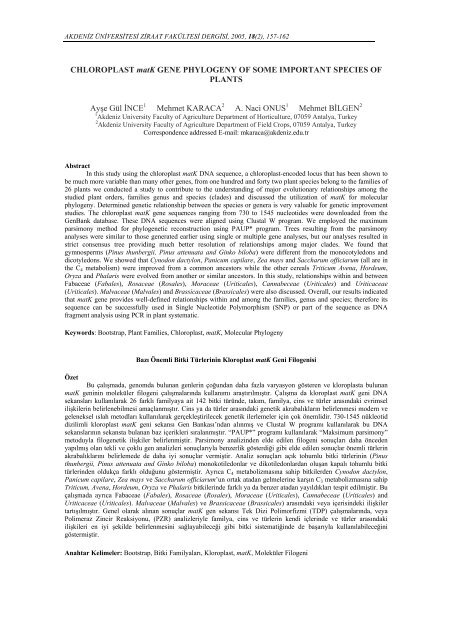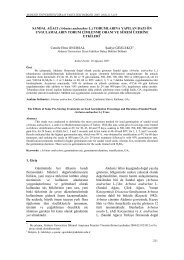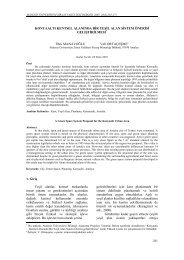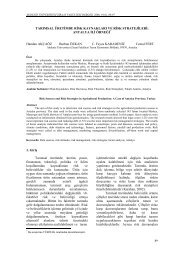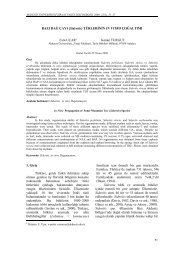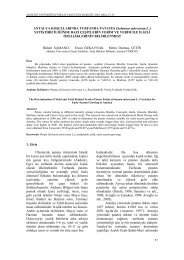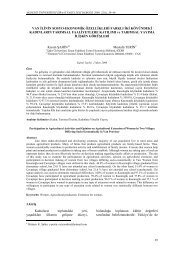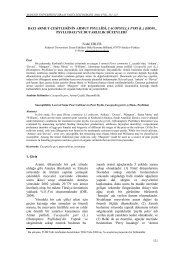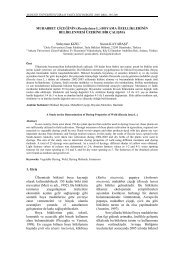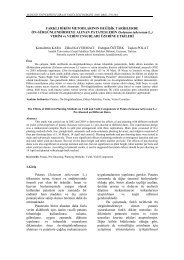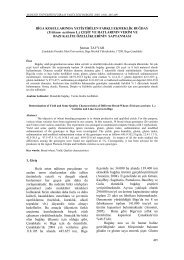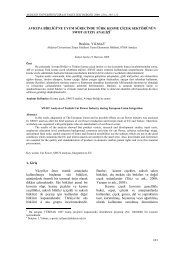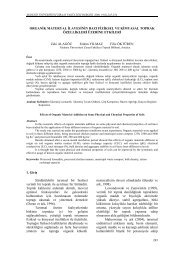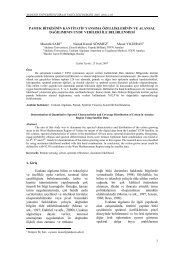CHLOROPLAST matK GENE PHYLOGENY OF ... - ResearchGate
CHLOROPLAST matK GENE PHYLOGENY OF ... - ResearchGate
CHLOROPLAST matK GENE PHYLOGENY OF ... - ResearchGate
Create successful ePaper yourself
Turn your PDF publications into a flip-book with our unique Google optimized e-Paper software.
AKDENİZ ÜNİVERSİTESİ ZİRAAT FAKÜLTESİ DERGİSİ, 2005, 18(2), 157-162<strong>CHLOROPLAST</strong> <strong>matK</strong> <strong>GENE</strong> <strong>PHYLOGENY</strong> <strong>OF</strong> SOME IMPORTANT SPECIES <strong>OF</strong>PLANTSAyşe Gül İNCE 1 Mehmet KARACA 2 A. Naci ONUS 1 Mehmet BİLGEN 21 Akdeniz University Faculty of Agriculture Department of Horticulture, 07059 Antalya, Turkey2 Akdeniz University Faculty of Agriculture Department of Field Crops, 07059 Antalya, TurkeyCorrespondence addressed E-mail: mkaraca@akdeniz.edu.trAbstractIn this study using the chloroplast <strong>matK</strong> DNA sequence, a chloroplast-encoded locus that has been shown tobe much more variable than many other genes, from one hundred and forty two plant species belong to the families of26 plants we conducted a study to contribute to the understanding of major evolutionary relationships among thestudied plant orders, families genus and species (clades) and discussed the utilization of <strong>matK</strong> for molecularphylogeny. Determined genetic relationship between the species or genera is very valuable for genetic improvementstudies. The chloroplast <strong>matK</strong> gene sequences ranging from 730 to 1545 nucleotides were downloaded from theGenBank database. These DNA sequences were aligned using Clustal W program. We employed the maximumparsimony method for phylogenetic reconstruction using PAUP* program. Trees resulting from the parsimonyanalyses were similar to those generated earlier using single or multiple gene analyses, but our analyses resulted instrict consensus tree providing much better resolution of relationships among major clades. We found thatgymnosperms (Pinus thunbergii, Pinus attenuata and Ginko biloba) were different from the monocotyledons anddicotyledons. We showed that Cynodon dactylon, Panicum capilare, Zea mays and Saccharum officiarum (all are inthe C 4 metabolism) were improved from a common ancestors while the other cereals Triticum Avena, Hordeum,Oryza and Phalaris were evolved from another or similar ancestors. In this study, relationships within and betweenFabaceae (Fabales), Rosaceae (Rosales), Moraceae (Uriticales), Cannabeceae (Uriticales) and Uriticaceae(Uriticales). Malvaceae (Malvales) and Brassicaceae (Brassicales) were also discussed. Overall, our results indicatedthat <strong>matK</strong> gene provides well-defined relationships within and among the families, genus and species; therefore itssequence can be successfully used in Single Nucleotide Polymorphism (SNP) or part of the sequence as DNAfragment analysis using PCR in plant systematic.Keywords: Bootstrap, Plant Families, Chloroplast, <strong>matK</strong>, Molecular PhylogenyBazı Önemli Bitki Türlerinin Kloroplast <strong>matK</strong> Geni FilogenisiÖzetBu çalışmada, genomda bulunan genlerin çoğundan daha fazla varyasyon gösteren ve kloroplasta bulunan<strong>matK</strong> geninin moleküler filogeni çalışmalarında kullanımı araştırılmıştır. Çalışma da kloroplast <strong>matK</strong> geni DNAsekansları kullanılarak 26 farklı familyaya ait 142 bitki türünde, takım, familya, cins ve türler arasındaki evrimselilişkilerin belirlenebilmesi amaçlanmıştır. Cins ya da türler arasındaki genetik akrabalıkların belirlenmesi modern vegeleneksel ıslah metodları kullanılarak gerçekleştirilecek genetik ilerlemeler için çok önemlidir. 730-1545 nükleotiddizilimli kloroplast <strong>matK</strong> geni sekansı Gen Bankası’ndan alınmış ve Clustal W programı kullanılarak bu DNAsekanslarının sekansta bulanan baz içerikleri sıralanmıştır. “PAUP*” programı kullanılarak “Maksimum parsimony”metoduyla filogenetik ilişkiler belirlenmiştir. Parsimony analizinden elde edilen filogeni sonuçları daha öncedenyapılmış olan tekli ve çoklu gen analizleri sonuçlarıyla benzerlik gösterdiği gibi elde edilen sonuçlar önemli türlerinakrabalıklarını belirlemede de daha iyi sonuçlar vermiştir. Analiz sonuçları açık tohumlu bitki türlerinin (Pinusthunbergii, Pinus attenuata and Ginko biloba) monokotiledonlar ve dikotiledonlardan oluşan kapalı tohumlu bitkitürlerinden oldukça farklı olduğunu göstermiştir. Ayrıca C 4 metabolizmasına sahip bitkilerden Cynodon dactylon,Panicum capilare, Zea mays ve Saccharum officiarum’un ortak atadan gelmelerine karşın C 3 metabolizmasına sahipTriticum, Avena, Hordeum, Oryza ve Phalaris bitkilerinde farklı ya da benzer atadan yayıldıkları tespit edilmiştir. Buçalışmada ayrıca Fabaceae (Fabales), Rosaceae (Rosales), Moraceae (Uriticales), Cannabeceae (Uriticales) andUriticaceae (Uriticales). Malvaceae (Malvales) ve Brassicaceae (Brassicales) arasındaki veya içerisindeki ilişkilertartışılmıştır. Genel olarak alınan sonuçlar <strong>matK</strong> gen sekansı Tek Dizi Polimorfizmi (TDP) çalışmalarında, veyaPolimeraz Zincir Reaksiyonu, (PZR) analizleriyle familya, cins ve türlerin kendi içlerinde ve türler arasındakiilişkileri en iyi şekilde belirlenmesini sağlayabileceği gibi bitki sistematiğinde de başarıyla kullanılabileceğinigöstermiştir.Anahtar Kelimeler: Bootstrap, Bitki Familyaları, Kloroplast, <strong>matK</strong>, Moleküler Filogeni
Chloroplast <strong>matK</strong> Gene Phylogeny of Some Important Species of Plants1. IntroductionRecent advances in DNA sequencingtechnologies and molecular biology enableus to characterize genomes of organismsand now many ongoing genome projects forvarious species are providing valuableinsights into their biology and utilizations.The application of molecular biologyinformation to systematic and evolution hasresulted in significant contributions to plantsystematics and in the emergence ofmolecular systematics as a solidinterdisciplinary field (Mort et al., 2001).Nucleotide sequence variability inchloroplast DNA (cpDNA or plastid DNA)at inter-(between families or genus) andintra-specific level (within species orvarieties) has been surveyed primarily inorder to analyze the phylogeneticrelationships and plant identification studies(Tamura et al., 2004).The <strong>matK</strong> gene, a chloroplastgenome encoded locus located within theintron of the chloroplast gene trnK, encodesa maturase on the large single-copy sectionadjacent to the inverted repeat of everyplant families, has high rates of substitutioncompared to other chloroplast genes and itsDNA sequence is one of the least conservedplastid genes; therefore, has beeneffectively used in plant evolution andaddresses the phylogenetic questions invarious taxonomic levels (Ito et al., 1999;Fuse and Tamura, 2000).The <strong>matK</strong> gene has severaladvantages in comparison to other genesincluding the organelle genome genes. Firstof all the <strong>matK</strong> gene evolves approximatelythree times faster than the widely usedplastid genes rbcL and atpB. It is in thechloroplast genome and in many cases it ismaternally inherited. This gene has areasonable size, high rate of substitution,large proportion of variation at the first andthe second codon positions, low transitiontransversionratio, and the presence ofmutationally conserved sectors. Researchhas shown that the variations at nucleic acid(DNA) and amino acid levels evenlydistributed throughout the entire gene, andthe 5’ region of the <strong>matK</strong> gene appears tohave more variation than the 3’ region inmany monocotyledons and dicotyledons.Because of these unique characteristics,<strong>matK</strong> gene sequences (at both nucleic acidsand amino acid sequence levels) have beenused successfully to resolve family andeven species level relationships (Steele andVigalys, 1994; Brochmann et al., 1998;Koch et al., 2001; Tamura et al., 2004).In this article, we report the results ofphylogenetic analyses of chloroplast <strong>matK</strong>gene sequences from 142 plant speciesbelong to families of 26 plants and 22orders. Relationships within and betweenmonocotyledons, dicotyledons andgymnosperms were discussed. Thisinformation may facilitate the utilization ofthe genetic resource in wild germplasm andprovide an important basis for addressingthe many intriguing questions involving thebiogeography and genome evolution studies.Also determined genetic relationships mayprovide valuable information for bothconventional and modern plant breedingstudies.2. Material and MethodsA total of 142 <strong>matK</strong> sequences weredownloaded from GenBank database(http://www.ncbi.nlm.nih.gov/Genbank/index.html). These <strong>matK</strong> DNA sequences werethen aligned using the Clustal W program(Thompson et al., 1994). Result of thealignments showed that there were variablenumbers of indels in <strong>matK</strong> gene. All gapcharacters were scored as missing datarather than a fifth character. Sequencesranging from 730 to 1545 bp in lengthprovided a data set of 2089 bp afteralignment.Phylogenetic analyses of thesequence data were conducted using theparsimony method using Petroselinumcrispum <strong>matK</strong> DNA sequence as reference.The sequence data were also analyzed witha neighbor-joining (NJ) and UnweightedPair Group Mean Average UPGMAmethods as implemented in PAUP* 4.0(Swofford, 2002). The level of support forbranches of the phylogenetic trees wasevaluated with the bootstrap analysis(Felsenstein, 1985) to verify the length of158
Chloroplast <strong>matK</strong> Gene Phylogeny of Some Important Species of PlantsDicotAngiospermMonocotGymnospermUmbelliferaAsteraceaeHamameliceaeVitaceaeTheaceaeOleaceaeLamiaceaeRosaceaeMalvaceaeChenopodeceaeUrticaceaeFabaceaeBrassicaceaePoaceaeAlliaceaeAgayaceaeBromoliaceaeLiliaceaeZingiberaceaeOrchidaceaePinaceaeGinkoceaePetroselinum crispumHelianthus porteriHelianthus annuusHelianthus tuberosusHelianthus simulansHelianthus eggertiiHelianthus verticillatusHelianthus agrestisHelianthus heterophyllusLactuca sativaLiquidambar formosanaVitis ripariaVitis viniferaCamellia granthamianaCamellia japonicaCamellia sinensisCamellia sasanquaOlea europaeaJasminum nudiflorumSalvia splendensMalus x domesticaMalus sieversiiMalus asiaticaMalus micromalusMalus sylvestrisMalus baccataMalus hupehensisMalus orientalisPrunus virginianaRosa multifloraRosa spinosissimaRosa laevigataRosa bracteataRosa roxburghiiRosa persicaCannabis sativaHumulus lupulusMorus albaFicus caricaGossypium anomalumGossypium somalenseGossypium longicalyxGossypium hirsutumGossypium barbadanseGossypium raimondiiGossypium gossypioidesGossypium schwendimaniiGossypium turneriGossypium trilobumGossypium davidsoniiGossypium robinsoniiGossypium bickiiHibiscus rosasinensisHibiscus syriacusCola acuminataSpinacia oleraceaAtriplex patulaBoehmeria platanifoliaGlycine maxPhaseolus coccineusPhaseolus vulgarisVigna peduncularisVigna umbellataVigna unguiculataVigna longifoliaLotus purshianusLotus corniculatus var japonicusCicer canarienseCicer macracanthumMedicago medicaginoidesMedicago monanthaMedicago monspeliacaMedicago sativaMedicago truncatulaMelilotus albaMelilotus indicaTrifolium albopurpureumTrifolium gracilentumTrifolium microcephalumTrifolium resupinatumTrifolium fragiferumTrifolium repensTrifolium hirtumTrifolium burchellianumTrifolium dubiumLathyrus aphacaLathyrus vestitusLathyrus latifoliusLathyrus sativusLathyrus tingitanusLens culinarisLens ervoidesVicia americanaVicia grandifloraVicia sativaVicia benghalensisVicia articulataVicia hirsutaArachis pintoiArabis drummondiiArabidopsis lyrataArabidopsis thalianaBrassica creticaBrassica incanaBrassica oleraceaBrassica rapaBrassica rupestrisRaphanus sativus var nigerRaphanus sativus var sativusRaphanus raphanistrumAllium grayiIris japonicaYucca aloifoliaYucca australisAnanas ananassoidesLilium superbumLilium columbianumLilium maculatumZingiber miogaZingiber officinaleBrassia arcuigeraCynodon dactylonPanicum capillareZea maysSaccharum officinarumOryza sativaOryza longistaminataOryza nivaraOryza altaOryza minutaAvena sativaPhalaris arundinaceaTriticum aestivumHordeum vulgareHordeum vulgare subsp vulgareHordeum vulgare subsp spontaneumHordeum bulbosumHordeum arizonicumHordeum depressumPinus thunbergiiPinus attenuataGinkgo bilobaFigure 1. Most parsimonious UPGMAtree for 142 species of plantsby the maximum parsimonymethod based on nucleotidesequences of the <strong>matK</strong> gene.160
A. G. İNCE, M. KARACA, A. N. ONUS, M. BİLGENPetroselinum crispumGlycine maxPhaseolus coccineusPhaseolus vulgarisVigna peduncularisVigna umbellataVigna unguiculataVigna longifoliLotus purshianusLotus corniculatus var japonicusCicer canarienseCicer macracanthumLathyrus aphacaLathyrus vestitusLathyrus latifoliusLathyrus sativusLathyrus tingitanusLens culinarisLens ervoidesVicia americanaVicia grandifloraVicia sativaVicia benghalensisVicia articulataVicia hirsutaMedicago medicaginoidesMedicago monanthaMedicago monspeliacaMedicago sativaMedicago truncatulaMelilotus albaMelilotus indicaTrifolium albopurpureumTrifolium gracilentumTrifolium microcephalumTrifolium repensTrifolium resupinatumTrifolium fragiferumTrifolium burchellianumTrifolium hirtumTrifolium dubiumArachis pintoiMalus x domesticaMalus sieversiiMalus asiaticaMalus micromalusMalus sylvestrisMalus baccataMalus hupehensisMalus orientalisPrunus virginianaRosa multifloraRosa laevigataRosa spinosissimaRosa bracteataRosa roxburghiiRosa persicaBoehmeria platanifoliaCannabis sativaHumulus lupulusMorus albaFicus caricaAllium grayiYucca aloifoliaYucca australisIris japonicaAnanas ananassoidesLilium superbumLilium columbianumLilium maculatumZingiber miogaZingiber officinaleBrassia arcuigeraCynodon dactylonPanicum capillareZea maysSaccharum officinarumOryza sativaOryza longistaminataOryza nivaraOryza altaOryza minutaAvena sativaPhalaris arundinaceaTriticum aestivumHordeum vulgareHordeum vulgare subsp vulgareHordeum vulgare subsp spontaneumHordeum bulbosumHordeum arizonicumHordeum depressumPinus thunbergiiPinus attenuataGinkgo bilobaArabis drummondiiArabidopsis lyrataArabidopsis thalianaBrassica creticaBrassica incanaBrassica oleraceaBrassica rapaBrassica rupestrisRaphanus sativus var nigerRaphanus sativus var sativusRaphanus raphanistrumGossypium anomalumGossypium longicalyxGossypium hirsutumGossypium barbadanseGossypium somalenseGossypium raimondiiGossypium gossypioidesGossypium schwendimaniiGossypium turneriGossypium trilobumGossypium davidsoniiGossypium robinsoniiGossypium bickiiHibiscus rosasinensisHibiscus syriacus yCola acuminataSpinacia oleraceaAtriplex patulaLiquidambar formosanaVitis ripariaVitis viniferaCamellia granthamianaCamellia japonicaCamellia sinensisCamellia sasanquaOlea europaeaJasminum nudiflorumSalvia splendensHelianthus porteriHelianthus heterophyllusHelianthus eggertiiHelianthus verticillatusHelianthus tuberosusHelianthus annuusHelianthus simulansHelianthus agrestisLactuca sativaFigure 2. Most parsimonious NJ tree for 142 species ofplants by the maximum parsimony methodbased on nucleotide sequences of the <strong>matK</strong>gene. Numbers above branches indicatepercentage of bootstrap values estimated from100 bootstrap replicates.161
Axor Massaud


